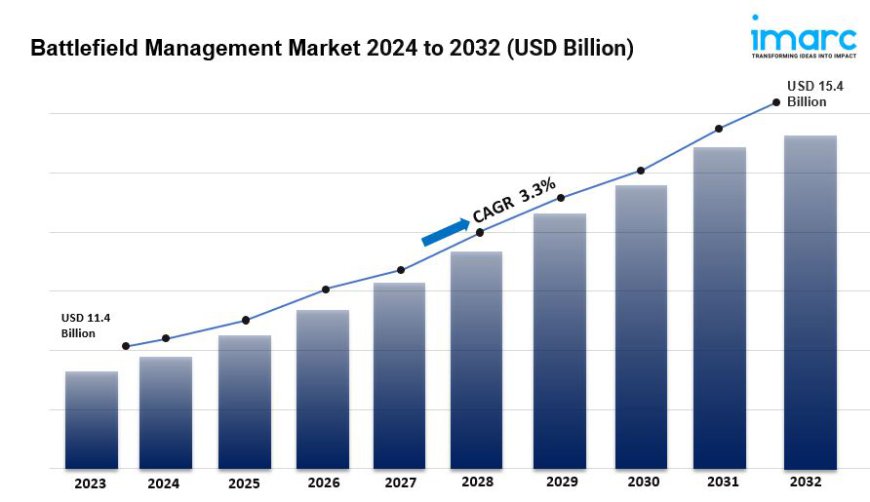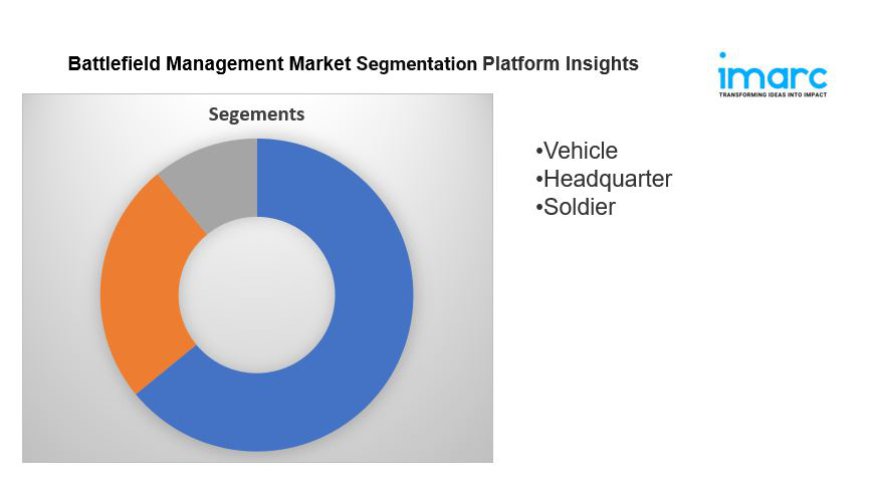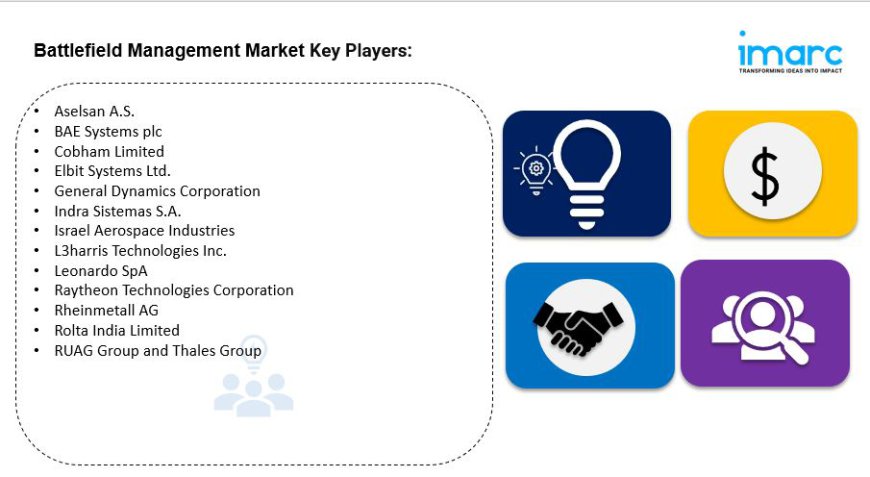Battlefield Management Market Size, Growth, Demand, Top Companies and Forecast 2024-2032
The global battlefield management market size reached US$ 11.4 Billion in 2023. Looking forward, IMARC Group expects the market to reach US$ 15.4 Billion by 2032, exhibiting a growth rate (CAGR) of 3.3% during 2024-2032. The escalating need for real-time situational awareness during warfare, rapidly changing modern battle strategies, and the increasing complexity of military operations represent some of the key factors driving the market.

Battlefield Management Industry
Summary:
- The global battlefield management market size reached US$ 11.4 Billion in 2023.
- The market is expected to reach US$ 15.4 Billion by 2032, exhibiting a growth rate (CAGR) of 3.3% during 2024-2032.
- North America leads the market, accounting for the largest battlefield management market share due to its significant defense spending.
- Vehicle accounts for the majority of the market share in the platform segment due to the high demand for enhanced mobility.
- Computer hardware devices hold the largest share in the battlefield management industry owing to the demand for reliable processing power.
- Computing system remain a dominant segment in the market because it forms the backbone of the battlefield management system.
- Army represents the leading application segment as land-based forces require advanced systems for real-time coordination.
- The increasing defense spending globally is a primary driver of the battlefield management market.
- Technological advancements in defense systems and growing focus on cybersecurity are reshaping the battlefield management market.

Industry Trends and Drivers:
- Technological Advancements in Defense Systems:
Technological innovations, particularly in artificial intelligence (AI), machine learning (ML), and data analytics, are transforming the battlefield management market. The adoption of AI-powered decision-making tools is allowing commanders to process large volumes of data in real-time, enhancing situational awareness and the speed at which decisions can be made. Machine learning algorithms, for example, can predict enemy movements or potential threats by analyzing historical data and real-time intelligence. These systems provide military personnel with predictive insights that allow them to make more informed decisions on the battlefield. Additionally, modern communication systems such as fifth generation (5G) and satellite technologies are improving connectivity between troops and command centers, even in remote locations. The fusion of these technologies is enabling faster, more accurate, and efficient battlefield management.
- Increased Defense Spending Globally:
Countries across the world are ramping up their defense budgets to maintain military superiority and address evolving security threats. This increased spending is particularly notable in several countries, which have been prioritizing the development and deployment of modern battlefield management systems. These nations are investing heavily in new technologies that can enhance command and control capabilities, allowing for faster and more efficient decision-making during combat. Moreover, geopolitical tensions in different regions are pushing countries to prioritize defense modernization, leading to higher spending on battlefield management solutions. The increased budgets allow for the procurement of cutting-edge systems that integrate advanced communication, navigation, and surveillance technologies.
- Growing Focus on Cybersecurity:
Cybersecurity has become a critical concern for military forces worldwide. Battlefield management systems now handle vast amounts of sensitive information, making them attractive targets for cyber-attacks. As a result, there is a growing emphasis on developing systems that ensure the security of communications and data exchange. Secure transmission of information between command centers, field units, and unmanned systems is essential for preventing adversaries from gaining access to critical intelligence. The rise in cyber threats has prompted defense forces to invest in encryption, secure communication networks, and intrusion detection systems as integral components of their battlefield management infrastructure. Additionally, with the increased use of autonomous systems like drones and unmanned vehicles, cybersecurity measures must be embedded into every layer of technology to prevent hacking and sabotage.
Request for a sample copy of this report: https://www.imarcgroup.com/battlefield-management-market/requestsample
Battlefield Management Market Report Segmentation:
Breakup By Platform:
- Vehicle
- Headquarter
- Soldier
Vehicle account for the majority of shares due to the high demand for enhanced mobility and real-time communication systems in military vehicles for tactical operations.

Breakup By Component:
- Wireless Communication Devices
- Imaging Devices
- Computer Software
- Tracking Devices
- Wired Communication Devices
- Computer Hardware Devices
- Night Vision Devices
- Display Devices
- Others
Computer hardware devices dominate the market because of the need for robust and reliable processing power to support complex battlefield management systems.
Breakup By System:
- Navigation and Imaging System
- Communication and Networking System
- Computing System
Computing system represents the majority of shares as it forms the backbone for data processing, decision-making, and integration of various battlefield technologies.
Breakup By Application:
- Army
- Air Force
- Navy
Army holds the majority of shares because land-based forces require advanced systems for real-time coordination, logistics, and command control.
Breakup By Region:
- North America (United States, Canada)
- Asia Pacific (China, Japan, India, South Korea, Australia, Indonesia, Others)
- Europe (Germany, France, United Kingdom, Italy, Spain, Russia, Others)
- Latin America (Brazil, Mexico, Others)
- Middle East and Africa
North America holds the leading position owing to its significant defense spending, technological advancements, and extensive military modernization programs.
Top Battlefield Management Market Leaders:
The battlefield management market research report outlines a detailed analysis of the competitive landscape, offering in-depth profiles of major companies.
Some of the key players in the market are:
- Aselsan A.S.
- BAE Systems plc
- Cobham Limited
- Elbit Systems Ltd.
- General Dynamics Corporation
- Indra Sistemas S.A.
- Israel Aerospace Industries
- L3harris Technologies Inc.
- Leonardo SpA
- Raytheon Technologies Corporation
- Rheinmetall AG
- Rolta India Limited
- RUAG Group and Thales Group

Browse full report with TOC & List of Figures: https://www.imarcgroup.com/request?type=report&id=2141&flag=C
If you require any specific information that is not covered currently within the scope of the report, we will provide the same as a part of the customization.
About Us:
IMARC Group is a global management consulting firm that helps the world’s most ambitious changemakers to create a lasting impact. The company provide a comprehensive suite of market entry and expansion services. IMARC offerings include thorough market assessment, feasibility studies, company incorporation assistance, factory setup support, regulatory approvals and licensing navigation, branding, marketing and sales strategies, competitive landscape and benchmarking analyses, pricing and cost research, and procurement research.
Contact us:
IMARC Group
134 N 4th St. Brooklyn, NY 11249, USA
Email: sales@imarcgroup.com
Tel No:(D) +91 120 433 0800
United States: +1-631-791-1145

 jamessmithjimmy12
jamessmithjimmy12